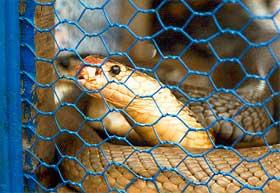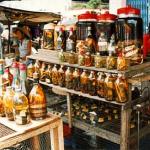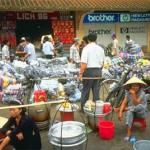A Canadian's Impressions of the Streets of Saigon: Snake Wine and Spring Rolls
"Uncle Ho!" smiled a man who had been meticulously polishing the chrome rim between the spokes of his motorbike. Pointing at the image of Ho Chi Minh on the T-shirt I was wearing, he proclaimed, "He was good man. He was very good man." His smile grew larger as he offered his hand. "My English name is Tom. Welcome to Vietnam."
Tom gave motorbike tours. Up until a year ago, he had been a cyclo driver; in two years, he assured us, he would own a taxi. "If you want a tour, you will find me here. This is my office," he grinned widely with a gesture sweeping all of Lam Son Square. When asked whether he preferred the name Ho Chi Minh City or Saigon, he replied without hesitation. "Saigon. It is more poetic."
Even though construction cranes are raising the new Ho Chi Minh City all around her, old Saigon has not disappeared. Beneath the steel and glass, the low-rise French colonial city flourishes. Now that the American embargo has been lifted, Saigon is fast recapturing the glory days of the nineteenth century.
Saigon is a walking city. Whether along the tree-lined promenades or down side streets and lane ways, the sidewalks have a vigor and vitality; as you stroll, the faces and personalities change, but the smiles are constant. A twenty-minute walk in any direction from Lam Son Square will produce insights into the heart of Saigon life.
Under a tree, a barber's scissors click rapidly as she cuts the hair of a man squatting on the ground; the cigarette between her puckered lips dangles precariously close to the client's head. A man uses a cleaver to chop a thick snake, dropping the chunks into a buyer's plastic bag. Food vendors ladle hot soups and stews into bowls and serve them to hungry patrons. One enterprising man with patches, glue and a hand pump repairs flat tires, locating the puncture by using a war helmet full of water. Women in conical hats and scarves wrapped over their mouths and noses are bent almost double as they sweep the sidewalks with short brooms.
Beggars are plentiful, insistent and obnoxious. Ragged girls in bare feet tug at shirts chanting, "Give me money." Mothers with babies will follow doggedly, looking sad as they extend their palms. Men with missing arms or legs hound and entreat persistently.
One vendor working from a piece of plywood balanced between the handlebars and seat of his bicycle, rolls betel nuts sprinkled with lime into areca leaves and offers them to those eager to chew the elixir. Another offers samples of rambutans, sweet sticky fruit with a red spiny skin. Baseball hats made from recycled Pepsi tins are displayed on a card table. A man sits among cages full of songbirds; it is unclear if they are pets or food. A grizzled toothless woman peering from beneath her conical hat hunkers beside a number of live turtles stacked in a cardboard box; on pieces of cardboard nearby are mounds of dry and flattened frogs and what appear to be dead beetles. At another table, fake GI Zippo lighters are proffered; the inscription on one reads, "I'll respect you in the morning, baby. Vietnam, 1968." A cyclo driver has curled up in the seat of his vehicle and snores loudly.
Coconut vendors are omnipresent as they wander the streets with their balanced shoulder baskets. A man in his undershirt sits behind an old Underwood typewriter and squints through the smoke from the cigarette clenched in his lips as he pecks out his client's letter.
The sidewalks near the "Old Market" along Ton That Dam, a couple of blocks from the Saigon River and the area around the "Central Market" at Ham Nghi and Le Lei have an especially high concentration of vendors. From fold up tables or mats on the ground, vendors hawk ornate boxes carved from cinnamon wood, knock-off designer watches, lacquerware, opium pipes, switchblade knives and name brand liquor.
At one street stall stacked with material, a tailor measures a young lady for an ao dai, the suit of pants and long side split shirt that is uniquely Vietnamese. Designs for western fashions can be selected from a catalogue and tailored in the material of your choice in less than twenty-four hours.
The narrow and deep noodle shop located along a side street off Nguyen Hue was crowded, cramped, and noisy. Our bowls of pho--rice noodle soup containing chicken, bean sprouts, chopped green onions, chili peppers, coriander, star anise and garlic--were placed on the table still steaming; the plump spring rolls of chopped shrimp, ground pork, bean sprouts, finely chopped water chestnuts and a hint of coconut were served sizzling.
Reassured by the hotness and made more confident by a recent Hepatitis A booster, we enjoyed our first authentic Vietnamese food. We were not bold enough, however, to sample the more exotic items available. At the next table, deep fried birds the size of sparrows were held by the feet and eaten whole, the tiny bones crunching audibly. We also decided to forego the steamed sea slugs, baked turtle and grilled snakes that appeared to be popular.
Along a shelf at the back of the noodle shop were a number of large bottles, each containing rice wine, ginseng root, seed pods, pieces of bark and several large snakes rearing up as if lured out of a basket by a flute-playing snake charmer. The eyes of the cobras glared menacingly, their thin filament tongues distended. By their appearance, they went into the bottle live, for their dilated hooded necks were several times larger than the openings.
Noticing my hesitant curiosity, the elderly shop owner tensed his arms, flexed his biceps, pounded his chest and clenched his fists in an effort to communicate health and virility. Other patrons, their teeth reddened from betel, nodded and grinned making similar gestures. A boy of about eight who spoke perfect English urged me to sample a glass, explaining that it was very good medicine. "Maybe tomorrow," I said, realizing even as I declined that I would regret the missed opportunity.
Of the innumerable horrific images that exploded from television sets during the war, three have melded together and are etched in my psyche: the stark terror in the eyes of the naked children fleeing a napalm bombing; the yellow-robed monk engulfed in flames of protest while the cameras rolled; and the wounded soldier crawling farther and farther away from his legs. In a conversation with Tom, the motorbike tour guide, I described these media memories, knowing that his images were live and unedited. It would be understandable for the tears and terror of the past to turn into present day rancor. "That is in the past," Tom countered, his hand flickered as if sweeping something away. "We look forward only. To prosperity. The past is over."
It was six in the morning and we were at breakfast in the ninth floor restaurant of the Caravelle Hotel. A waiter who was setting tables yawned heartily, picked his nose and then began scratching his crotch. A cockroach the size of a mouse scuttled from under the buffet table as the waiter watched absently. After the short walk across the square, breakfast was continued at the Hotel Continental, the grande dame of Saigon hotels built in 1885.
This is a two-wheeled city; of the seven million people who live here, one million own motorbikes and they all seem to be on the road at the same time. There is always at least one passenger; often there are two or three. An entire family is sometimes seen on a bike--the father driving with a child in his lap and another child wedged in front of the mother riding sidesaddle on the back. Many female drivers wear long gloves that go beyond their elbows; most drivers and passengers wear a bandanna over their mouths and noses. Teenage girls in short skirts drive one-handed while the other is placed strategically for discretion. All drivers buzz their horns continuously. At the rare stoplight, the riders stand like masked bandits, waiting and revving, perhaps a dozen wide and fifty deep, like a gathering posse, rumbling and waiting.
If the motorbikes are not carrying passengers, they are used to transport loads. Two riders hung on to enough wood to build a shed; a flower seller was almost hidden beneath the day's flowers. Another carried scores of trussed up live ducks. A man carrying a tottering load of birds in cages honked relentlessly while maneuvering around a cyclo; two others were transporting a twelve-foot ladder.
Because there are few traffic lights, walking across the street can be an adventure. There are few gaps in the flow of bicycles, motorbikes and cyclos. What is needed is a mindset; you must accept that you will arrive on the opposite side safely. Walk slowly, but deliberately and most importantly, do not show any hesitancy. Miraculously, the traffic will flow around you like a current around a rock.
After dark, it is cruising time. Especially on weekend evenings, around Ho Chi Minh Plaza and Lam Son Square, the spear lights slice the night like knights' lances, in the Vietnamese version of the Spanish paseo.
A friend and I were at a sidewalk cafe near city hall and overlooking the small park with its statue of Ho Chi Minh. Motorbikes droned like hornets. Our spring rolls were presented on toothpicks stuck into a whole pineapple and brought to our table with much ceremony. "Please have good food," the waiter smiled, bowing.
Rearing back, its neck flared into a wide hood and its tongue flicked out, the cobra sits glaring at me as I write. Accompanying the snake in its bottle of clear liquid, float orange berries and a ginseng root. The souvenir bottle, purchased at the Century Saigon Hotel's gift shop, requires only a twist of the sealed cap and I could drink the healthful elixir. I planned on doing just that. Tomorrow.
 ThingsAsian
ThingsAsian




















